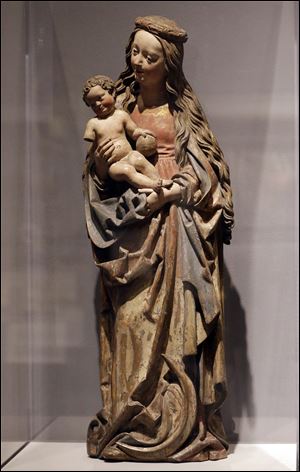
EDITORIALS
In terms of art: No sale
Foundations have come forward to help save the DIA collection from being sold; it’s Michigan’s turn to step up
1/18/2014
The sculpture “Virgin and Child on the Crescent Moon” by Niklaus Weckmann, owned by the city of Detroit, is displayed at the Detroit Institute of Arts. The fate of Detroit’s art is in question amid the city's bankruptcy proceedings.
In art museums across America, benches are placed here and there to face a particularly striking work of art. A visitor can sit, contemplate in silence, absorb poetry on canvas, and leave refreshed.
Such an experience is “uplifting, sustenance — people would call it soul food,” says Brian Kennedy, director of the Toledo Museum of Art.
Click here to read more Blade editorials.
It should not disappear from Detroit, one of the nation’s poorest big cities. Too many people think of the arts as frills, rather than foundations of a community or life-changing catalysts for its people.
A group of foundations this week announced pledges of $330 million toward a deal that would help to preserve the city-owned Detroit Institute of Arts’ collection from being auctioned off to help pay the city’s bankruptcy and pension fund debts.
The groups, including The Ford Foundation, the John S. and James L. Knight Foundation, and the Kresge Foundation plus six others, are to be commended for offering help.
Now it is the turn of Michigan’s governor and lawmakers to step up.
The foundations’ potential contribution falls far short of the $454 million to $867 million worth assigned by Christie’s auction house to a key part of the collection, which includes works by Monet, Van Gogh, and Matisse.
Those 2,800 pieces of art, out of about 66,000 works, are considered most vulnerable to sale because they were bought with city money and are not restricted by donors’ stipulations. The DIA, however, has said that its total collection is vulnerable because all of it is owned by the city.
While the promise of donations was worked on for months with mediators, it is unclear whether the agreement would be accepted by U.S. Bankruptcy Judge Stephen Rhodes or Detroit’s emergency manager, Kevyn Orr.
Mr. Orr has said everything is on the table to pay off the city’s $18 billion in debt, including the city museum’s holdings. Retirees, who are owed an estimated $3.5 billion, and other creditors are demanding to be paid.
Now that the foundations are offering to help, Gov. Rick Snyder and the Republican-controlled Legislature should step up to contribute tax dollars to the fund.
“This is too important for them not to be involved,” Grosse Pointe Park philanthropist Paul Schaap, who pledged $5 million, told the Detroit News.
Snyder spokesman Sara Wurfel called the donors’ announcement “positive news.” She said any state participation “would be in partnership with the Legislature.”
That sounds like the governor is passing the buck.
“Toledo’s art museums contribute to a sense of place, to public esteem and civic pride,” Mr. Kennedy says. “In the case of the great cities of the Midwest, we happen to be truly fortunate in that those who built our cities understood the necessity of demonstrating to citizens the greatest achievements and creative practice of the human capacity.”
Elected representatives of the public should help to preserve that invaluable heritage.